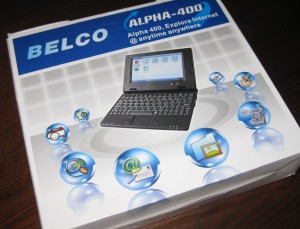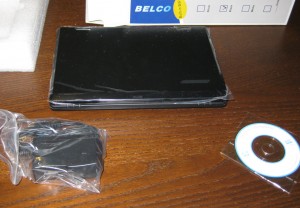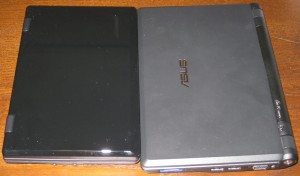I bit the proverbial bullet and ordered that cheap MIPS-based subnotebook from Geeks.com. Ordering was a comedy of errors as something went wrong with the order while I was away on vacation and was cancelled upon my return, which is when I noticed that the subnotebook had decreased in price by another $20, a discount that has since ended. But the Alpha-400 arrived today, almost at the same time that I read the Engadget headline EMTEC’s sub-$400 10-inch Gdium netbook gets specced. The Gdium, you might recall, is another, slightly more capable, MIPS-based laptop slated for general availability somewhere between now and the end of time. The headline made me think that the laptop’s release is eminent. But a deeper investigation reveals no firm or even loose commitment regarding shipment.

But I have the cheaper MIPS-based laptop in my hands, one that goes by many names. In this region, it is called the Belco Alpha-400. Let’s see what it can do. First things first, here are the complete contents of the box, minus styrofoam (which I’m thankful was there since the box was sent in a mere envelope):

There’s (1) subnotebook computer, (1) AC adapter, and (1) 80mm CD-ROM, clearly labeled with its capacity of 225 MB along with a goofy panda picture, but no other markings (it turns out to contain the English user manual and a large file named Recovery_Bel-09641-b-R3-en-2-20081106.rar).
Then there is this impressive warning on the display when first opened (the same sticker is on the bottom of the unit); click for a larger view:

I have no idea what they’re talking about regarding that 8MB file limit. I can certify due to tests performed that A) there is more than 8MB available on the file system (in fact, only about 330 MB of the gigabyte available is used when the system is fresh), and B) the file system does not have some arbitrary size limit of 8 MB.
So, first impression: The experience is nothing to write home about; it certainly won’t be replacing my dear Eee PC 701 which, BTW, is slightly larger than the Alpha-400. Here is a size comparison:

The keyboard is smaller and stiffer than the Eee. The mouse buttons are tough to double click and are on either side of the track pad rather than beneath it. It might be a personal preference as to which one a user will like, but I don’t think I have ever seen this button configuration before.
Wireless confused me at first because I expected its configuration button to be on the Settings panel (where the ethernet configuration lives) rather than the Internet panel (where the web application lives). But it had no trouble connecting to my encrypted wireless network. Even though this device is restricted to 802.11b wireless, that’s still an improvement over my Eee PC’s wireless which seemed to stop working completely several months ago. The speeds I had read about on the internet are accurate: transfers top out at around 500-520 kbytes/sec.
Software: Sure enough, it uses Bon Echo which is a Firefox 2.0-derived web browser. Its “Play” panel implies gaming activities, but actually features the Media Player and Flash Player. The latter is the Xiptech Flash Player and I haven’t been able to figure out which media player it uses. Maybe Kaffeine or SMPlayer. I know I have seen the interface before, but the app is not forthcoming about who it actually is. It doesn’t support Ogg Vorbis or Theora, which is pretty much heresy for a Linux-based subnotebook. The only media I got to play was a PCM WAV file (but I didn’t spend too much time on it).
The computer also comes with an application called Video OnLine which maps to a program called LinVideos. I’m pretty sure this is supposed to be a YouTube screen-scraping application for gathering FLV video. It doesn’t work, which means that YouTube probably changed their protocol since this software was finalized for shipment.
You all know what I really want this for– just the MIPS CPU hooked up to some RAM with a base Linux system around it, thanks. I followed the advice I received regarding achieving root access and so now the thing can sit in another room, waiting for remote accesses while I investigate it through the command line. It looks like /bin/player is the standalone Flash Player while /mozopt/lib/mozilla-firefox/plugins/libplayer.so is the Mozilla plugin. Both have lots of FFmpeg symbols. No sign of FFmpeg symbols in the Linvideos application.
I have my foot in the door. Now I need to get serious about building a MIPS toolchain. Here is some basic CPU info:
$ uname -a Linux (none) 2.4.20-celf3 #1 Tue Oct 14 00:44:30 HKT 2008 mips unknown $ cat /proc/cpuinfo system type : JzRISC processor : 0 cpu model : V4.15 BogoMIPS : 335.05 wait instruction : yes microsecond timers : yes tlb_entries : 32 extra interrupt vector : yes hardware watchpoint : yes VCED exceptions : not available VCEI exceptions : not available
Perhaps one of these CPUs:
http://www.rockbox.org/twiki/bin/view/Main/IngenicJz47xx
i too just got one of these from geeks.com, i’d like to work with some people on hacking up these netbooks to be more useful. drop me a line at the email that was provided in this form.
i look forward to hearing what else you’ve managed to do.
Not a whole lot just yet. I hold out hope that these lower power machines can still be made useful in a modern settings (hey, iPhone did it).
But I will also hopefully have a Gdium on the way soon.
the Gdium is out? where!?! =] as for the alpha 400, there’s alot of good information out there seemingly spearheaded by a bunch of dutch guys. i hope to get a customized version of linux on this, so i gotta set up a toolchain/cross compiler.
I might be getting one as part of a pre-release program. More details here: http://multimedia.cx/eggs/more-non-x86-subnotebook-news/
I’ll keep you posted on this blog if I have any success with toolchains. Subscribe via RSS so you don’t miss anything (though it helps to be interested in multimedia hacking as well :-) ).
I just got the thing myself. Same /proc/cpuinfo as above,
V70 . If you turn off the wifi via the green antenna icon,
ifconfig eth0 up seems to persistanty revive it. Of course,
“just got the thing” means “just got it and got vt3 working”.
sh and ed are from busybox, which means I need a real distro.
Or a source for real /bin stuff as binaries in tarballs
for the stock setup I guess.
I like it. I’m on it now. .7 kg is about right. I’d like to
see how it runs with plain X without all the Glop.
rick_hohensee@email.com